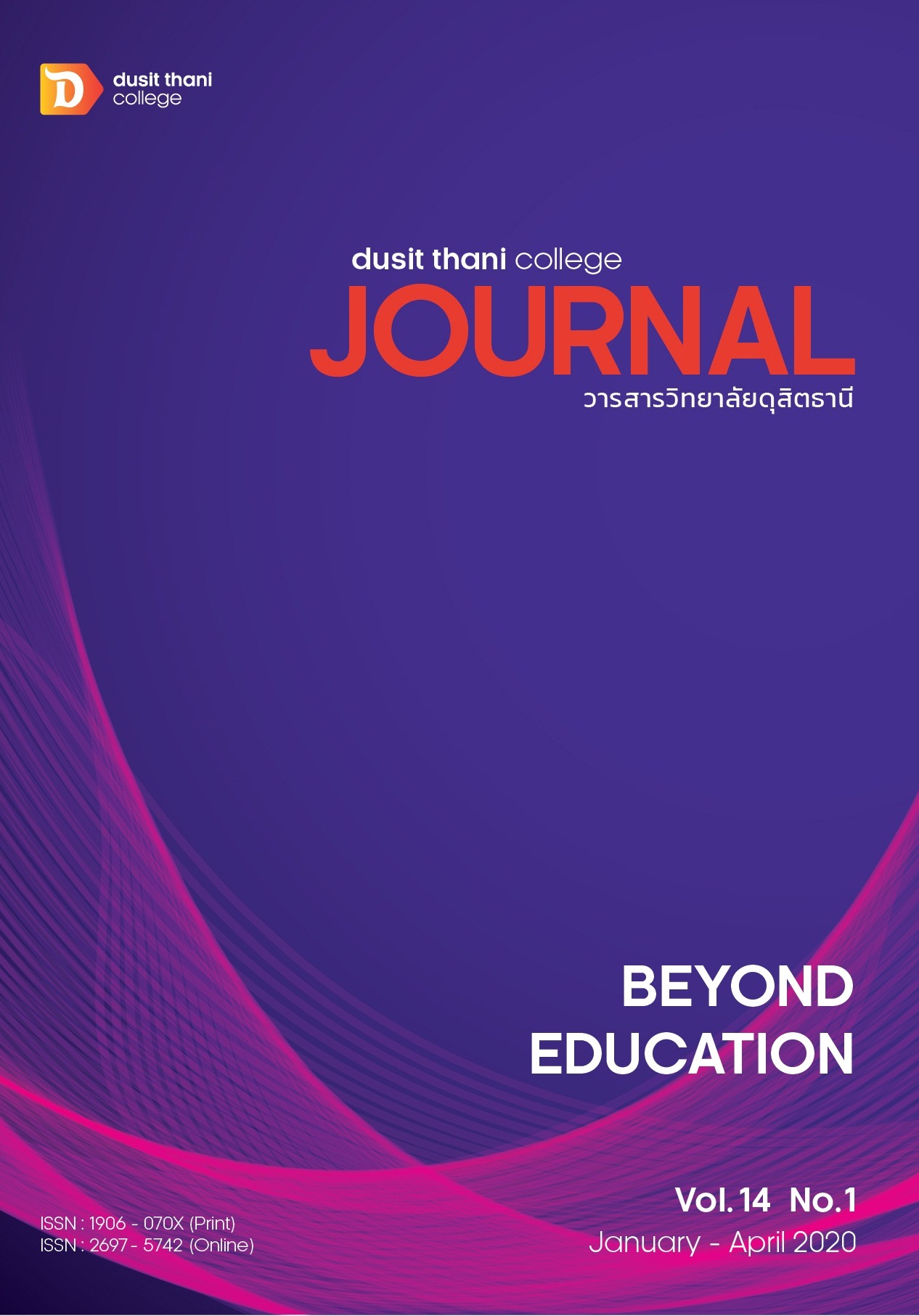Opinions of Thai University Students Towards Sneaker Experiential Advertising
Main Article Content
Abstract
This research aims to examine personal and psychological factors ,composed of beliefs, values, learnings, motives perceptions, reference groups and influence groups, opinions towards sneakers experiential advertising of Thai university students and compare opinions among groups with differences in personal and psychological data. A campus intercept survey was conducted at Rajamangala University of Technology Thanyaburi, with 328 students who voluntarily completed questionnaires in the first semester. Both descriptive statistics; frequency; mean, standard deviation and inferential statistics; independent t-test and one-way ANOVA were employed for data analysis.
Findings were: 1) highest mean scores; learning that product well before purchasing, motive of purchasing was necessity, 2) students seemed to favor much on sense experiences higher than others. 3) comparisons showed statistically significant difference of mean scores of opinions towards experiential advertising between groups with different personal and psychological data.
This research contributes to the literature on experiential advertising and also on unique characteristics of Thai university students on sneaker experiential advertising. Practical implications for advertising agents in Thailand, suggesting that they should concern more on these uniqueness characteristics of Thai university students in creating experiential sneaker advertising.
Article Details
Article Screening Policy
- All research and academic articles to be published must be considered and screened by three peer reviews in the relevant field / article.
- All articles, texts, illustrations and tables published in the journal are the personal opinions of the authors. Editors don't always have to agree. And no responsibility whatsoever is the sole responsibility of the author.
- The articles to be published must never be published. Where did you first publish? And not in the consideration of other journals If the audit found that there has been a duplicate publication It is the sole responsibility of the author.
- Any article that the reader sees as being plagiarized or impersonated without reference. Or mislead the work of the author Please let the journal editor know it will be your greatest blessing.
References
Journal of Business, 15(2), 39-48.
2. Chaipat.or.th. (2017).The Chaipattana Foundation - Concepts - Sufficiency Economy & New Theory. [online] Available at: http://chaipat.or.th/eng/concepts-theories/sufficiency-economy-new-theory.html [Accessed 11 Nov. 2018].
3. Chen, W., Li, F., Lin, T., & Rubinstein, A. (2015, June). Combining traditional marketing and viral marketing with amphibious influence maximization. In Proceedings of the Sixteenth ACM Conference on Economics and Computation (779-796). ACM.
4. Cunningham, C. (2008). You are what are on your feet: men and the sneaker subculture. Journal of Culture & Retail Image, 1(1), 1-6.
5. D'Adamo, A., (2016). 3 Things Marketers Can Learn From Sneaker Brand Marketing | WMI. [Online] Available at: http://www.womensmarketing.com/blog/3-things-marketers-can-learn-from-sneaker-brand-marketing [Accessed 17th October 2018]
6. Fournier, S. (1994). A consumer-brand relationship framework for strategic brand management. Ph.D. University of Florida.
7. Katrine, D., & Harini, C. (2018). The Analysis of Effect of Sense, Feel, Think, Act, And Relate As The Experiential Marketing Variables to Customer Loyalty of Andelir Hotel Semarang. Journal of Management, 4(4).
8. Keller, K. (1993). Conceptualizing, Measuring, and Managing Customer-Based Brand Equity. Journal ofMarketing, 57(1)
9. Kotler, P., & Armstrong, G. (2010). Principles of marketing. Pearson.
10. Lefton, T. (2017). Has sneaker market lost its tread?. [online] Sportsbusinessdaily.com. Available at: https://www.sportsbusinessdaily.com/Journal/Issues/2017/12/04
/Marketing-and-Sponsorship/Sneakers.aspx [Accessed 29 Oct. 2018].
11. MacInnis, D., Park, C. and Priester, J. (2009). Handbook of brand relationships. London: Routledge
12. Mongsawad, P. (2010). The philosophy of the sufficiency economy: a contribution to the theory of development. Asia-Pacific Development Journal, 17(1), 123 - 143.
13. Nugraha, P. A. I. (2017). The effect of social media experiential marketing toward customer’ satisfaction (a study in Chingu Korean Fan Café Bandung Indonesia). International Journal of Business and Administrative Studies, 3(2) 56 - 63
14. Schmitt, B. (1999). Experiential marketing: A new framework for design and communications. Design Management Journal (Former Series), 10(2), 10 - 16.
15. Sheth, J. N., Sisodia, R. S., & Sharma, A. (2000). The antecedents and consequences of customer-centric marketing. Journal of the Academy of marketing Science, 28(1), 55-66.
16. Solomon, M.R (2011). Motivations and Values: Consumer behavior, 2011, Glotoal Edition 9e.
17. SpotXer., (2018). The Value of Audience-Based Advertising: Q&A with Randy Cooke. [Online] Available at: https://www.spotx.tv/resources/blog/spotxer/value-audience-based-advertising-qa-randy-cooke/ [Accessed 17th October 2018]
18. Todor, R. D. (2016). Blending traditional and digital marketing. Bulletin of the Transilvania University of Brasov. Economic Sciences. Series V, 9(1), 51.
19. Yamane, T. (1967). Statistics: An introductory analysis (2nd ed.). New York, NY : Harper& Row.


